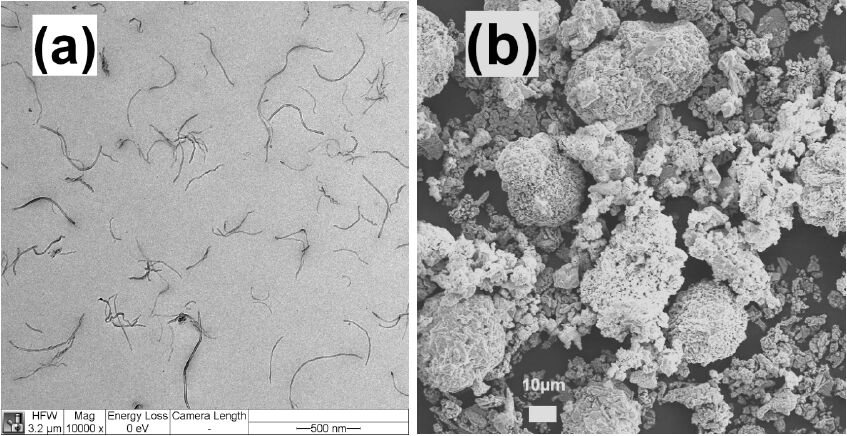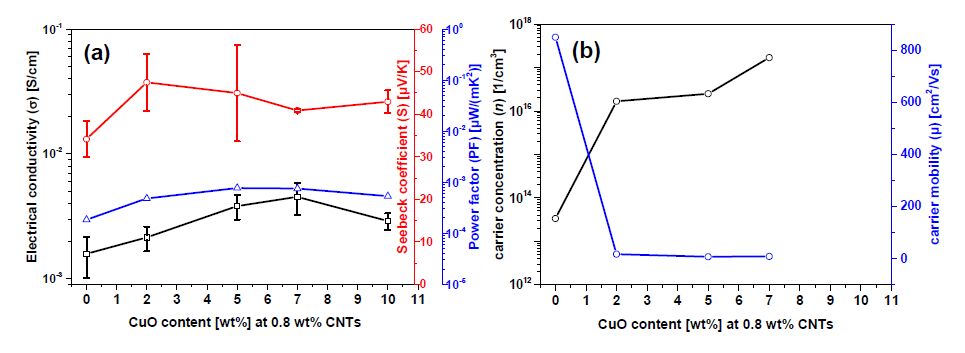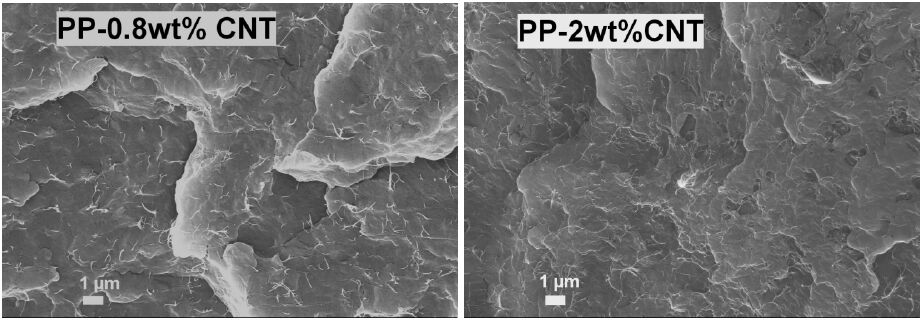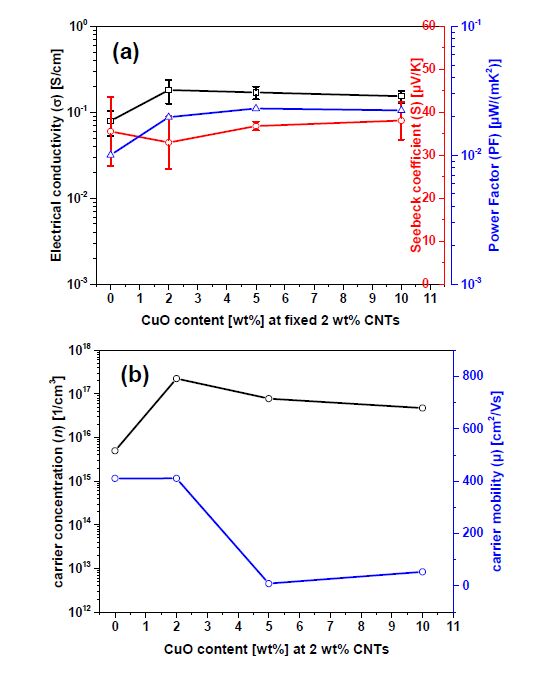| Abbreviations | | | |
| TE | thermoelectric | CNT | carbon nanotube |
| PCTFE | polychlorotrifluoroethene | PP | polypropylene |
| SEM | scanning electron microscopy | TEM | Transmission electron microscopy |
1. Introduction
Thermoelectric (TE) generators are solid state energy harvesters without moving parts. They can be used to recover abundant waste heat into electricity. Their energy conversion efficiency depends on the figure of merit ZT of the used materials, which is defined as ZT = σS2T/κ with σ as the electrical conductivity, S the Seebeck coefficient, κ the thermal conductivity and σS2 the power factor [1]. The power factor represents the efficiency of the conversion of heat into electricity. Current commercial TE devices typically consist of bismuth telluride alloys, which have high power factor (~4500 µW/(mK2)), but also high thermal conductivity ~1.2 W/mK at room temperature [2]. These materials contain rare earth elements and are toxic, heavy and brittle. More environmental friendly TE materials are in focus, of which the components should be abundant, inexpensive and flexible [3].
Carbon nanotubes (CNTs) are materials with high electrical conductivity, flexibility, and mechanical properties. CNTs have been widely applied to fabricate flexible electronics, such as organic field effect transistors [4,5] and solar cells [6]. Their application as TE materials is also emerging. Despite of their high electrical conductivity, most commercial CNTs have relative small Seebeck coefficient ranging from 10 to 40 µV/K [7]. In a recent paper, it is demonstrated that semiconducting singlewalled CNT films (purity > 99%) possess high Seebeck coefficient up to 1285 µV/K (cf. 125 µV/K for metallic CNT film) and higher Seebeck coefficient is expected with smaller CNT diameter [8]. However, the separation of semiconducting singlewalled CNTs from metallic ones is challenging and time consuming. Furthermore, the high thermal conductivity of singlewalled CNTs (~2000 W/mK at room temperature [9]) and CNT buckypapers (e.g. 75 W/mK [10]) reduces the ZT of these materials. The inclusion of CNTs into organic materials could greatly reduce the thermal conductivity down to 0.5 W/mK [11] while the electrical conductivity of the composites remains high. In particular, for insulating polymers, the addition of conducting fillers, i.e. CNTs enables the formation of an electrical network for efficient charge transport. In this case, both the Seebeck coefficient and electrical conductivity strongly depend on the selected CNT type as CNTs are the only conductive component inside the composite. The thermal conductivity of composites is lower than 1W/mK attributed to the low intrinsic thermal conductivity of polymers [12]. As the electrical conductivity is proportional to the carrier concentration while the Seebeck coefficient is inversely proportional to it [1], an optimized power factor
is obtained by the variation of the CNT concentration inside the insulating polymer matrix.
Most of reported work on polymer/CNT composites for TE materials is based on solution mixing [11,13,14,15,16,17,18,19]. Only few papers focused on melt mixed polymer/CNT composites for TE application even though the melt mixing technique can be easily scaled up to current industrial large scale fabrication and prevents the usage of solvents [20,21,22]. These reported that melt mixed composites with CNTs have very low Seebeck coefficients (~15 µV/K). Addition of semiconductor/metal oxide together with conductive fillers is confirmed to improve the Seebeck coefficient of composites [19,21,23]. Andrei et al. [19] demonstrated that a high Seebeck coefficient up to 127 µV/K was obtained in a polychlorotrifluoroethene (PCTFE) composite filled with 87.5 wt% of Cu2O/graphite (cf. 12.6 µV/K for PCTFE/graphite), of which a very low power factor of 2.75 × 10−5 µW/mK2 was obtained due to the low electrical conductivity of the composite.
Here, we focus on the development of melt mixed composites as TE materials, in which a common thermoplastic material, namely polypropylene (PP), was used as the matrix. Commercial singlewalled CNTs were selected to generate high electrical conductivity of the composites. CuO powder, a nontoxic compound with high Seebeck coefficient [23], was used together with CNTs to enhance the Seebeck coefficient and the corresponding power factor of the composites. Two different CNT concentrations were selected to discuss the influence of CuO addition on the Seebeck coefficient and the power factor of the composites.
2. Materials and Method
2.1. Materials
Singlewalled CNTs (Tuball™, >75 wt% CNT content) were obtained from OCSiAl Company [24]. They contain metallic and semiconducting tubes in a ratio of roughly 1:2 [8]. CuO (>97%, diameter < 5 µm) powder and Brij 35 (average Mn: ~1198 g/mol) were purchased from Sigma Aldrich. PP granules (Moplen HP 400R) with a melt flow rate of 25 g/10 min (230 °C) were obtained from LyondellBasell Industries.
2.2. Composite preparation
PP granules were mechanically milled into powder with the diameter less than 1 mm. Defined amounts of PP powder and fillers (CNTs and CuO) were fed into a small-scale conical twin-screw microcompounder (Xplore 15 ccm, The Netherlands) with mixing conditions fixed to a melt temperature of 210 °C, a rotation speed of 250 rpm, and a mixing time of 5 min. The extruded strands were cut in granule sized pieces and compression molded at 210 °C using a pressure of 50 kN into circular plates using a press PW 40 EH (Paul Otto Weber GmbH, Germany). For electrical measurements plates with diameter of 60 mm and thickness of 0.3 mm were prepared whereas for thermal conductivity the size was 12.5 mm diameter and 2.0 mm thickness.
2.3. Sample characterization methods
The compression molded plates (60 mm diameter) of the composites were manually cut into strips (3-5 mm width, 30-35 mm length) and used for the electrical conductivity, Seebeck coefficient, and Hall Effect measurements. A 2-electrode test fixture combined with a Keithley electrometer E6517A was used for the electrical conductivity characterization (in plate electrical conductivity) for samples containing CNT contents up to 0.8 wt%. For samples with higher CNT concentration (>0.8 wt%, lower resistance), 4-electrode measurements (in plate electrical conductivity) were performed combined with Keithley multimeter DMM 2000. The Seebeck coefficient (in plate) at room temperature was determined using a SRX platform (Fraunhofer IPM, Germany). The Hall effect measurements were carried out on a IPM-HT-Hall-900K SYSTEM (Fraunhofer IPM, Germany). Scanning Electron Microscopy (SEM) observations of the CuO powder and the cryo-fractured composite surfaces were performed using a Gemini 1530 microscope. Transmission electron microscope (TEM, LIBRA-120, Carl-Zeiss GmbH, Germany) was used to investigate the CNT material. For this, the CNT dispersion in an aqueous Brij 35 solution was prepared using 10 min of ultrasound agitation and transferred to the TEM grid. The thermal conductivity of samples based on the laser flash principle was obtained using the Netzsch LFA 447 Nano Flash (Netzsch-Gerätebau GmbH, Selb, Germany). In this method, the density (r), specific heat (Cp) and thermal diffusivity (a) are used to calculate the thermal conductivity (k) (cross plate) of samples.
3. Results and Discussion
Figure 1 shows the TE properties of melt processed composites with CNTs only. With increasing amount of CNTs inside the insulating PP matrix an electrical conducting network is built up starting about 0.1 wt% CNTs [24]. Further addition of CNTs results in an increase in the electrical conductivity, and it saturates above a content of 4 wt% CNTs. In these PP/CNT composites, charge carriers only flow through neighboring CNTs. Consequently, the Seebeck coefficient of the composites is determined by the CNTs. For composites with <0.8 wt% CNTs, the electrical resistance is too high to give reliable Seebeck coefficient values. Thus, no value is presented. All prepared composites exhibit positive Seebeck coefficients due to the p-type characteristic of these CNTs. The highest Seebeck coefficient, 34.1 µV/K, is obtained at 1 wt% loading, which is in the range reported for CNT buckypapers with the same type of CNTs [8,25]. The increased electrical conductivity with respect to the CNT concentration is attributed to the charge carriers injected by CNTs: higher CNT concentration leads to higher carrier concentration. However, due to its inverse proportionality to the charge carrier concentration, a reduction tendency of Seebeck coefficient with CNT concentration is observed. Consequently, for these composites containing only CNTs, the highest power factor of 6.6 × 10−2 µW/mK2 is recorded for the composite containing 4 wt% CNTs.
CuO powder, a p-type semiconductor filler, was introduced into the PP matrix together with CNTs (see Figure 2 for the morphology of the used CNTs and CuO). Composites with low CNT concentration i.e. 0.8 wt% and high CNT concentration i.e. 2 wt% were selected. Both contents are above the percolation threshold of ca. 0.1 wt% CNTs [24] and result in electrical conducting composites.
At 0.8 wt% CNTs, the co-addition of CuO simultaneously improves the electrical conductivity and Seebeck coefficient. The electrical conductivity increases from 1.6 × 10−3 S/cm to 3.8 × 10−3 S/cm (138% increase) while the Seebeck coefficient was enlarged from 34.1µV/K to 45µV/K (32% increase) with 5 wt% CuO inclusion (see Figure 3a). As a result, a power factor of 9.6 × 10−4 µW/mK2 (cf. 1.8 × 10−4 µW/mK2 for the composite with only 0.8 wt% CNTs) was obtained. Further CuO addition, however, resulted in a decrease of the Seebeck coefficient. At 0.8 wt% CNT content, the composite is filled with limited amount of CNTs, at which a percolated but not dense electrical conducting network is formed. When CuO is added, it effectively injects heavy charge carrier into the composite, as it is evidenced by the 2 magnitudes higher carrier concentration (n) in Figure 3b. Correspondingly, the electrical conductivity is increased as it is determined by (e electron charge, µ charge carrier mobility). Due to the large effective mass of carriers from CuO [26], the charge carrier mobility of the composites is greatly reduced. Different to the large Seebeck coefficient reported for Cu2O/graphite filled PCTFE composites (87.5 wt% fillers and Cu2O/graphite (w/w) > 26.9) [19], only slight enhancement in the Seebeck coefficient of the composites is observed in our work despite of the large Seebeck coefficient of CuO (430 µV/K [27]). This may be attributed to the very low CuO concentration inside the composites and the inverse proportionality of Seebeck coefficient to the carrier concentration [1]. The high carrier concentration at 7 wt% CuO resulted in the reduced Seebeck coefficient.
A much denser percolated network is formed at 2 wt% CNTs compared to the composite with 0.8 wt% CNTs (see Figure 4). CuO addition also increases the electrical conductivity (125% increase at 2 wt% CuO), attributed to the higher carrier concentration by the CuO addition (see Figure 5). Nevertheless, the change in the Seebeck coefficient is trivial. This could be due to the denser CNT network: the carrier concentration (~1016 cm−3) with only 2 wt% CNTs is much higher than that in the composite filled with 0.8 wt% CNTs (~1013 cm−3). The portion of carriers contributed from CuO addition at 2 wt% CNTs is comparably smaller, leading to less increase in the electrical conductivity. At this CNT content, the carrier mobility is also reduced with the CuO addition. As the carriers from CNTs prevail over those from CuO, the Seebeck coefficient is similar to that of the composite without CuO addition. This is similar to the tendency observed in the Cu2O/graphite/PCTFE composite system with high content of graphite [19].
Despite of the inclusion of highly heat conducting CNTs, up to 2 wt% addition the composites have low thermal conductivity of ~ 0.5 W/mK (see Table 1). Inside these composites the fillers form loose networks with polymer layers at the contact points. They are electrically conducting due to hopping and tunneling effects. However, thermal conduction, coming from phonon scattering, is dominated by the polymer matrix having low thermal conductivity [28].The added CuO powder is randomly dispersed inside the matrix. Despite of the high thermal conductivity of CuO, the low packing density of CuO powder does not increase much the overall thermal conductivity of the composites similar to previous reports on polymer composites filled with aluminum nitride [29]. Thus, it is promising to use conducting CNTs and CuO to improve the power factor while the thermal conductivity of the composites remains low.
Table 1.Measured properties for the determination of the bulk thermal conductivity of samples.
| Density ρ [g/cm] | Specific heat Cp [J/(g*K)] | Thermal diffusivity α [mm2/s] | Thermal conductivity κ [W/mK] |
| Pure PP | 0.90±0.00 | 1.81±0.06 | 0.18±0.01 | 0.29 |
| PP-0.8wt%CNT | 0.86±0.02 | 1.70±0.07 | 0.26±0.02 | 0.37±0.02 |
| PP-2wt%CNT | 0.91±0.01 | 1.66±0.07 | 0.34±0.03 | 0.51±0.03 |
| PP-0.8wt%CNT-5wt%CuO | 0.92±0.00 | 1.62±0.04 | 0.27±0.02 | 0.40±0.02 |
| PP-2wt%CNT-5wt%CuO | 0.93±0.02 | 1.54±0.10 | 0.32±0.01 | 0.47±0.02 |
4. Conclusion
We have investigated the TE properties of melt mixed composites with thermoplastic PP as the matrix and a hybrid filler system of CNTs and CuO. For melt mixed composites, the hybrid filler system could be applied to fabricate composites with better TE properties than those with only CNTs. Nevertheless, attention has to be paid to the selected CNT concentration. At high CNT concentration, these composites are mainly determined by CNTs, resulting in less effect brought by the CuO addition. At low CNT concentration, at which a loose percolated network structure is formed, the CuO addition could simultaneously increase electrical conductivity and Seebeck coefficient, leading to a higher power factor.
Acknowledgments
We would like to thank Manuela Heber for the TEM investigations and thermal conductivity measurements. In addition, we thank OCSiAl Company for providing the singlewalled carbon nanotubes.
Conflict of Interest
The authors declare that there is no conflict of interest regarding the publication of this manuscript.









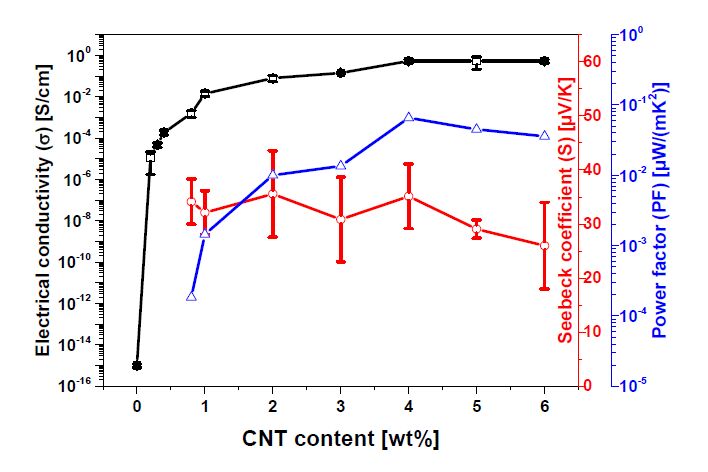
 DownLoad:
DownLoad: 